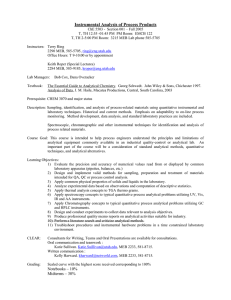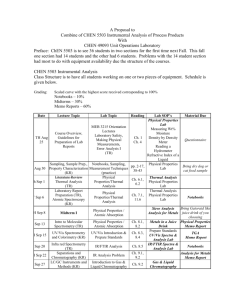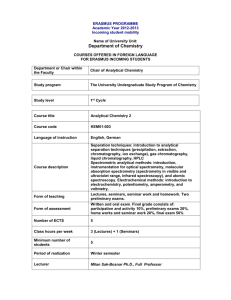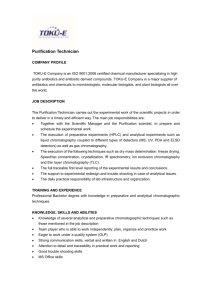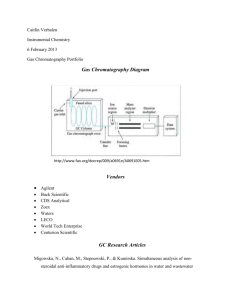PROCESS DESIGN I
advertisement
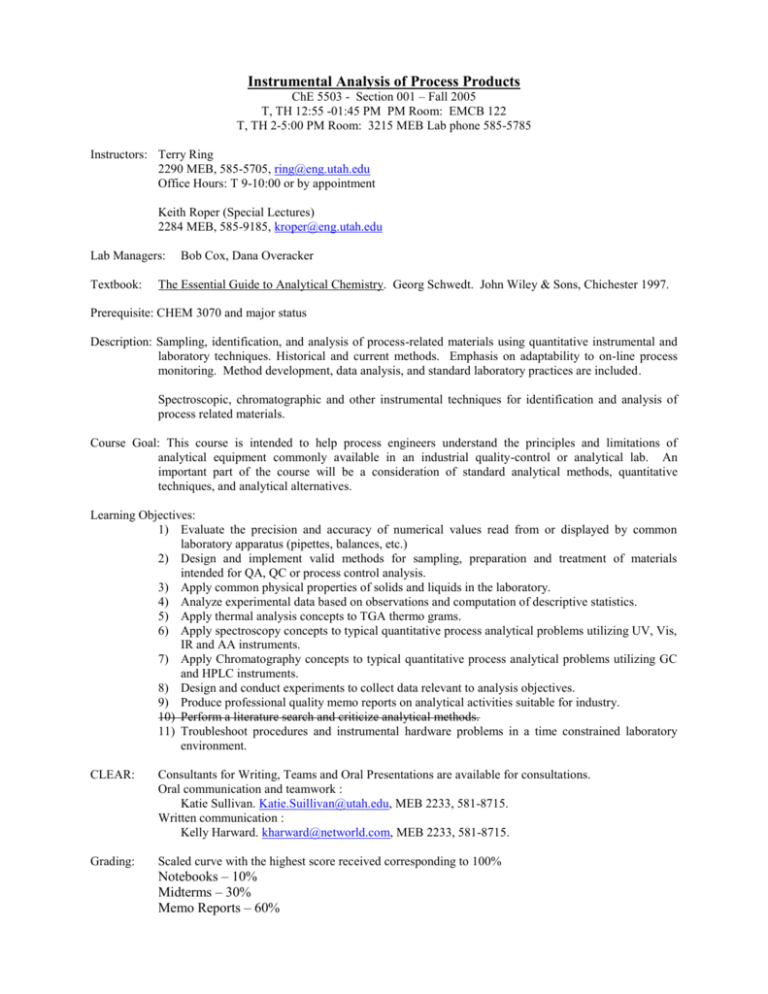
Instrumental Analysis of Process Products ChE 5503 - Section 001 – Fall 2005 T, TH 12:55 -01:45 PM PM Room: EMCB 122 T, TH 2-5:00 PM Room: 3215 MEB Lab phone 585-5785 Instructors: Terry Ring 2290 MEB, 585-5705, ring@eng.utah.edu Office Hours: T 9-10:00 or by appointment Keith Roper (Special Lectures) 2284 MEB, 585-9185, kroper@eng.utah.edu Lab Managers: Textbook: Bob Cox, Dana Overacker The Essential Guide to Analytical Chemistry. Georg Schwedt. John Wiley & Sons, Chichester 1997. Prerequisite: CHEM 3070 and major status Description: Sampling, identification, and analysis of process-related materials using quantitative instrumental and laboratory techniques. Historical and current methods. Emphasis on adaptability to on-line process monitoring. Method development, data analysis, and standard laboratory practices are included. Spectroscopic, chromatographic and other instrumental techniques for identification and analysis of process related materials. Course Goal: This course is intended to help process engineers understand the principles and limitations of analytical equipment commonly available in an industrial quality-control or analytical lab. An important part of the course will be a consideration of standard analytical methods, quantitative techniques, and analytical alternatives. Learning Objectives: 1) Evaluate the precision and accuracy of numerical values read from or displayed by common laboratory apparatus (pipettes, balances, etc.) 2) Design and implement valid methods for sampling, preparation and treatment of materials intended for QA, QC or process control analysis. 3) Apply common physical properties of solids and liquids in the laboratory. 4) Analyze experimental data based on observations and computation of descriptive statistics. 5) Apply thermal analysis concepts to TGA thermo grams. 6) Apply spectroscopy concepts to typical quantitative process analytical problems utilizing UV, Vis, IR and AA instruments. 7) Apply Chromatography concepts to typical quantitative process analytical problems utilizing GC and HPLC instruments. 8) Design and conduct experiments to collect data relevant to analysis objectives. 9) Produce professional quality memo reports on analytical activities suitable for industry. 10) Perform a literature search and criticize analytical methods. 11) Troubleshoot procedures and instrumental hardware problems in a time constrained laboratory environment. CLEAR: Consultants for Writing, Teams and Oral Presentations are available for consultations. Oral communication and teamwork : Katie Sullivan. Katie.Suillivan@utah.edu, MEB 2233, 581-8715. Written communication : Kelly Harward. kharward@networld.com, MEB 2233, 581-8715. Grading: Scaled curve with the highest score received corresponding to 100% Notebooks – 10% Midterms – 30% Memo Reports – 60% Add/Drop Policy: Add-Drop.pdf Notebooks: A professional laboratory note book will be required. The bookstore carries one with perforated pages and carbonless paper in it that is very useful. You can either photocopy your lab note book or tear out the carbon copy pages for handing in at the appropriate times. You need to keep your laboratory notebook current at all times so that your instructor can examine it when he/she feels like it. Exams: Date There will be two 50-minute closed-book midterm exams during the course of the ½ semester on the lecture materials and laboratory work. Lecture Topic Lab Topic Reading Lab SOP’s Material Due Physical Properties Lab MEB 3215 Orientation Measuring Wt% Lectures Course Overview, Moisture Laboratory Safety, TH Aug Guidelines for Ch. 1 Density by Density Making Physical Questionnaire 25 Preparation of Lab Ch. 4 Meter Measurements, Reports Reading a Error Analysis I Hydrometer (TR) Refractive Index of a Liquid Sampling, Sample Prep., Notebooks, Sampling, Physical Properties pp. 2-17, Bring dry dog or T Aug 30 Property Characterization Measurement Techniques Lab 38-43 cat food sample (KR) (practice) Literature Review Physical Thermal Analysis Ch. 6.1, Th Sep 1 Thermal Analysis Properties/Thermal Physical Properties 6.2 (TR) Analysis Lab Laboratory Report Thermal Analysis Physical Preparation (TR), Ch. 7.1, Physical Properties T Sep 6 Properties/Thermal Notebooks Atomic Spectroscopy 11.6 Lab Analysis (KR) Bring Gatoraid like Sieve Analysis Physical Properties / TH Sep 8 Midterm I Analysis for Metals juice drink of you Atomic Absorption choosing Intro to Molecular Physical Properties / Ch. 8.1, Metals in a Juice Physical Properties T Sep 13 Spectrometry (TR) Atomic Absorption 8.2 Drink Memo Report Prepare Standards TH Sep UV/Vis Spectrometry UV/Vis Introduction & Ch. 8.3, TGA UV/Vis Spectra & 15 and Colorimetry (KR) Prepare Standards 8.4 Memo Report Analysis Lab Infra red Spectrometry IR/FTIR Spectra & T Sep 20 IR/FTIR Analysis Ch. 8.5 Notebooks (TR) Analysis Lab TH Sep Separations and Ch. 9.1, Analysis for Metals IR Analysis Problem 22 Chromatography (KR) 9.2 Memo Report LC/GC Instruments and Introduction to Gas & Gas & Liquid T Sep 27 Ch. 9.2 Methods (KR) Liquid Chromatography Chromatography TH Sep Quantitative GC, Gas/Liquid Analysis HPLC Procedure for UV&FTIR Memo Ch. 9.2 29 Troubleshotting (KR) Problem Testing Sugars Reports Gas/Liquid Analysis T Oct 4 Midterm II Problem Process Analytical Last Labs GC/LC Memo TH Oct 6 Open Lab Project Chemistry (TR) Report Process (on-Line) T Oct 11 Analysis – Components Open Lab Project Notebooks (TAR) TH Oct Process (on-Line) Open Lab Project/ Lab Last Lab Memo 13 Analysis – Systems (TR) Cleanup Report T Oct 18 The University of Utah seeks to provide equal access to its programs, services and activities for people with disabilities. If you will need accommodations in the class, reasonable prior notice needs to be given to the Center for Disability Services, 162 Olpin Union Building, 581-5020 (V/TDD). CDS will work with you and the instructor to make arrangements for accommodations.
